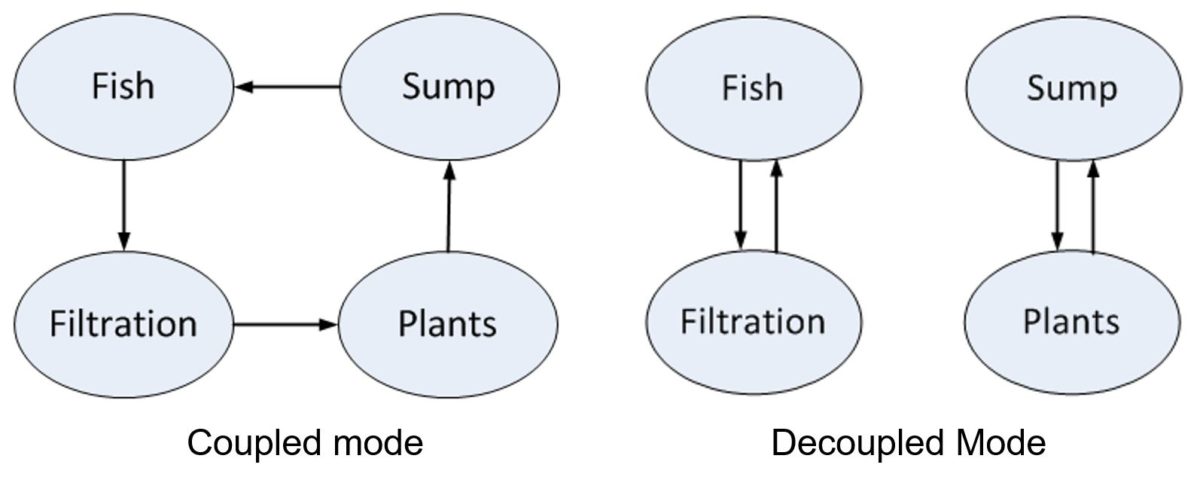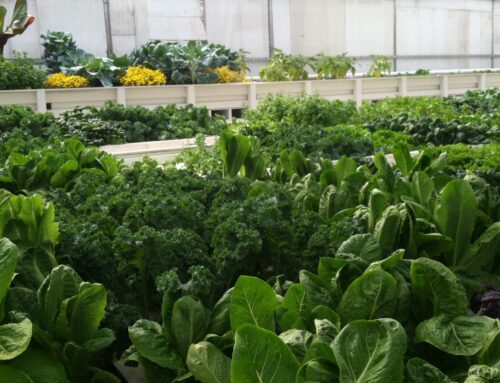Aquaponics is the raising of fish and plants in recirculating systems whereby the fish provide nutrients to the plants and the beneficial bacteria and plants help to return the water clean to the fish. It’s a highly productive eco-system with many extraordinary benefits, most notably its ability to conserve water with minimal if any discharge. While there is plenty of information out there about the benefits of aquaponics, let’s talk about some specifics regarding system design that could be particularly important for mitigating some of the risks and challenges often found with aquaponics. To provide some context and scale, I’m using our farm which occupies a 3,200 sq ft greenhouse. However, these ideas are applicable to any scale system.
Our aquaponics farm is designed to run in a “de-coupled” mode whereby the fish system can be operated independently of the hydroponic plant system. In normal operation, the water from the fish tanks flow through a series of filtration tanks and then out into the hydroponic system. A single pump returns this filtered clean water back to the fish system. In de-coupled mode, water from the fish tanks flows through the filtration system as it does in normal operation but it does not pass into the hydroponic troughs, it returns via a separate line back to the fish tanks. The filtration or life support system (LSS) is designed to provide the proper mechanical and biological filtration necessary to support appropriate water quality for the fish.
When the fish system is running on its own loop, the hydroponic system can also continue flowing via its own pump. In our farm, water pumps from the last deep water culture trough back to the first trough maintaining continuous flow through all four troughs.
Why decouple the system? Having the capability to isolate systems is important for a number of reasons. First and foremost, I don’t know any fish farmer (amateur or experienced) who hasn’t lost a good majority of their fish population at one point or another. Reasons for catastrophic fish deaths or illness can often be attributed to:
- Power failures and a lack of good backup, monitoring and alerting systems.
- Loss of water due to a blockage, overflow, rupture or operator error.
- Poor temperature control and water quality management. Variability in temperature can be highly stressful on fish and if you are not able to properly control temperature, fish may stop eating. If your fish stop eating this affects the nutrient dynamics in your system.
- Fish disease can also creep up quickly if the temperature, water quality and health of the fish are not being regularly monitored or you are not quarantining fish upon arrival from other sources.
Other reasons for having a decoupled system can include the fact that you can cycle your fish system independently while having plants growing in your hydroponic system. Or perhaps you started as a hydroponic grower and you are adding on an aquaculture component later in the cycle. Another popular design is to have your fish system in a separate facility or “head house” and your plants in a greenhouse. The systems can still be hydraulically connected so that fish water can be delivered to the plant system but may not necessarily return to the fish house.
Another advantage is that the hydroponic troughs (DWC) can be run at their own flow rate if so desired. In other words, when the fish and plant system is running together in normal operating mode using a single pump, the hydroponic pump could be used to circulate water at a variable flow rate through the DWC troughs as well. This requires the running of two pumps, but if increasing flow rate in the hydroponic troughs is desirable than the separate DWC pump and plumbing gives the operator the ability to do so. This could be beneficial in case water flow rates are too low through the troughs.
As is often the case in commercial aquaponics, the majority of the revenue is in the plants so having your plant system entirely dependent on your fish system creates a single point of failure scenario which can be avoidable in a decoupled system. If you have an issue with your fish system for any of the reasons cited above or more, you can still continue to run your hydroponic system on an organic nutrient solution so that you are able to maintain your production crop, your customers and revenue stream.
When reconnecting the two systems, it will be important to ensure ammonia and nitrites have been fully oxidized and are at safe levels for the fish. Water temperature, pH, Alkalinity and other factors affecting water quality may not be properly aligned between the fish and plant system so adjustments to these levels may be necessary to make a seamless transition and minimize stress on your fish. There may also be other elements of the hydroponic nutrient solution that could be problematic for fish at certain levels. For example we raise hybrid striped bass which are sensitive to potassium. It is always important to do your homework when you are considering adding something to your aquaponics environment. Thinning out the solution and exchanging with fresh water may be required to help reduce any potential toxicity and allow you to safely reconnect both environments.


